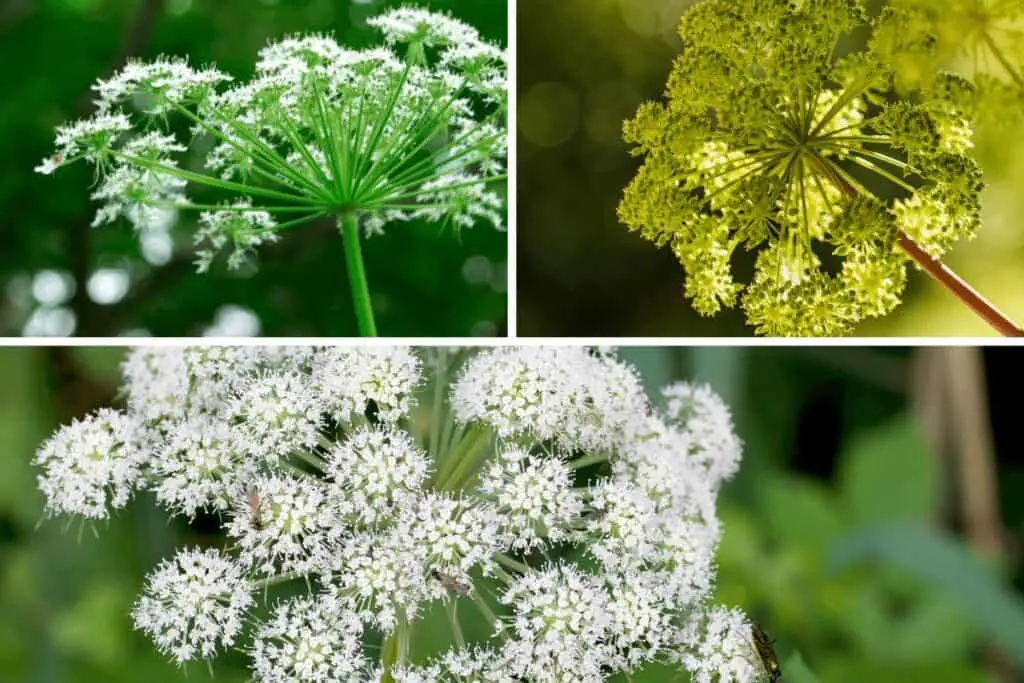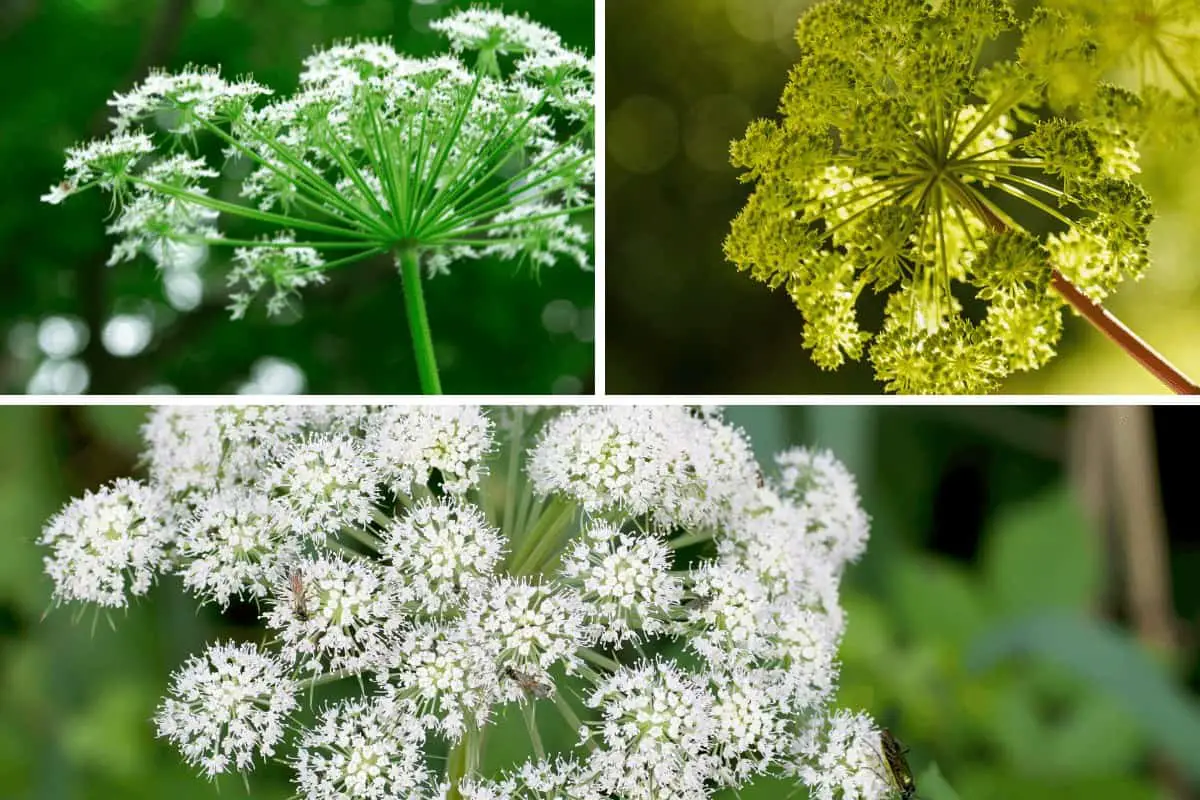Growing angelica is pretty easy once you get started, and it will reward you with a unique source of food, flavoring, and herbal remedies.
Did you know that when you enjoy a stirred or shaken martini the flavor comes from the Angelica root? Angelica is a European plant that has been a flavoring agent in many popular types of liquor, including gin and vermouth.
Also, the Angelica plant is closely related to carrots and is a member of the parsley family. The leaves of the plant may be dried and used in teas or as a seasoning. Angelica has many uses in cooking, flavoring, liqueur production, and perfumery as well.
You can even make candy out of it. From seed to root, all parts of this Angelica plant are edible.

What Is Angelica?
Angelica is a biennial which means each plant reaches maturity within a two-year cycle. In colder locations, it can take 3 years to mature and flower. In the first year, the plant produces only short clumps of compound leaves.
It grows tall in the second year, with flowers blooming followed by fruiting and going to seed. Once the seeds have ripened and been dispersed, the life cycle is complete, and plants generally die.
However, if you cut off the flower stalks before the seeds form, the plant will continue to grow for many more years. It self-seeds easily, so you will likely see new plants popping up year after year.
Angelica Growing Zone
SOIL REQUIREMENTS: Angelica requires a fairly rich, light, well-drained, but moist loam.
PLANT HEIGHT: 72-96″.
PLANT SPACING: 12-24″.
HARDINESS ZONES: Biennial in Zones 4-9.
How to Grow Angelica
Grows best in rich, moist soils in full sun to part shade. This plant is a biennial, which means it will die after producing seed in the second year. Early spring plantings are most successful. Tamp the seeds in moist potting mix in flats or trays, and just barely cover the potting mix.
Seeds need light germinate, as well as fluctuating temperatures between hot and cold. Move the trays outside where they will get the necessary temperature changes. After 21 days, bring the trays indoors for germinating. Transplant seedlings when they are 3-4” tall or direct sow, spacing plants 12-24” apart in rows that are 36” apart.
Seeds can be directly sowed in the garden. Refrigerate for four to six weeks, then sow seeds ¼” deep, 10 seeds per foot. Thin seedlings to 12-24 inches apart in each direction.
Growing Tips
- Start seeds in peat pots to avoid disturbing roots when transplanting.
- Do not attempt to transplant plants larger than 3-4 inches tall, as established plants have sensitive taproots.
- Cutting stalks at the end of the first year of growth will encourage flowering in the second year.
- Keep soil evenly moist but not waterlogged.
- Mulching will prevent the soil from drying out and inhibit the growth of weeds.
Companion Plants for Growing Angelica & Where to Buy
Managing Pests and Diseases
While not particularly prone to pests or disease, there are a few pesky critters and potential problems to keep an eye out for.
- Aphids
- Leaf Miners
- Spider Mites
Harvesting
All parts of angelica are edible. The leaves can be harvested in the first year. Harvest the root in the autumn of the first year, or spring of the second year, before the stalk has grown tall and begun to produce flower heads. When you are harvesting, always be sure to leave some of the plant intact to flower and go to seed, so it will continue to self-sow year after year.
Preserving
Angelica can be preserved in a variety of ways. The root can be dried, made into a tincture, or ground into a powder. Dry the leaves to use them as a culinary flavoring. You can also candy the stems, or use them to make jam.
Quick Reference Growing Guide
| Plant Type: | Biennial herb | Tolerance: | Various soil types, acidic soil |
| Native to: | Northern Europe, Middle East | Maintenance: | Low |
| Hardiness (USDA Zone): | 4-9 | Soil Type: | Any |
| Season: | Spring-fall | Soil pH: | 4.5-7.0 |
| Exposure: | Full sun to part shade | Soil Drainage: | Moist |
| Time to Maturity: | 2 years | Attracts: | Bees, butterflies, lacewings, ladybugs, wasps |
| Spacing: | 12-24 inches | Companion Planting: | Ferns, hellebores, lily of the valley, sweet woodruff |
| Planting Depth: | Surface (seeds) | Avoid Planting With: | Dill |
| Height: | 3-8 feet | Family: | Apiaceae |
| Spread: | 2-4 feet | Genus: | Angelica |
| Water Needs: | Moderate to high | Species:: | archangelica |
| Common Pests: | Aphids, leaf miners, spider mites | Common Disease: | Crown and root rot |
What are the Medicinal Uses for Angelica
The fleshy root is the primary part used in herbal remedies, though seeds and leaves are sometimes used as well. Historically, the stalks have been candied and used mainly as a confection.
Considered a warming and aromatic bitter tonic, angelica is often used to help improve weak digestive function, including indigestion, poor fat absorption, a feeling of heaviness, and heartburn.
Cultivation and History
It is thought that this plant is likely native to the Middle East, possibly Syria, or to northern European countries, including Norway, Russia, and Lithuania. It grows wild in the northern climates of Russia, Finland, Sweden, Norway, Denmark, Greenland, and Iceland.
FAQ
Is Angelica Easy to Grow from Seed?
The often-used root is a thick fleshy piece of vegetation that reminds one of a huge pale carrot. Provide Angelica with plenty of room in the garden as it can spread 2 to 4 feet (61 cm. to 1 m.) wide. Angelica is easy to propagate by seeds or division.
How to Grow Angelica Seeds Indoors
Tamp the seeds in moist potting mix in flats or trays, and just barely cover the potting mix. Seeds need light germination, as well as fluctuating temperatures between hot and cold. Move the trays outside where they will get the necessary temperature changes. After 21 days, bring the trays indoors for germinating.
Growing Angelica in Pots
Angelica does well in pots, but you need a container at least 16 inches in diameter and 12 inches deep. Mix a bit of sand or perlite in with a good quality potting mix and water regularly.
When Should I Start My Angelica Seed?
Sow in the fall or spring, 1/4- 3/8″ deep, 10 seeds per foot in well-prepared seedbeds. Space plants 12-24″ apart in each direction. LIGHT PREFERENCE: Sun/Part Shade. Angelica prefers part shade but will grow fine in full sun.
How Do I Propagate Angelica?
Drive a sharp spade into the center of the plant or lift the entire plant and divide the roots with a sharp knife. Replant the divisions immediately, spacing them 18 to 24 inches (46-61 cm.) apart. An easier method of angelica propagation is to allow the plants to self-seed
How Do You Germinate Angelica Seeds?
Indoor sown Angelica seeds should be planted into moist compost and stored in a fridge at 4°C or 39°F for 30 days, then moved to the warmth of around 18°C or 65°F to germinate.
How Quickly Does Angelica Grow?
Angelica is a biennial in USDA Hardiness Zones 4-9, which means each plant reaches maturity within a two-year cycle. In colder locations, it can take 3-4 years to mature and flower
What Part of The Angelica Plant Is Most Often Used?
The leaves of angelica are prepared as a tincture or tea and used to treat coughs, colds, bronchitis, and other respiratory complaints. They are considered gentler in action than preparations made from the root. The root is the most medically active part of the plant.
Is Angelica a Perennial Herb?
Angelica is an impressive hardy perennial plant that thrives in moist damp soil and will thrive in shade, this architectural beauty is perfect for the back of the border.
Can You Use Angelica Seeds?
Angelica has many uses in cooking, flavoring, liqueur production, and perfumery as well. You can even make candy out of it. From seed to root, all parts of this plant are edible
How Tall Does Angelica Plant Grow?
Angelica is a biennial plant that grows 3-7′ tall. Its large chartreuse leaves with inflated stem bases make a bold statement in the modern herb garden or flower border. The roots, leaves, seeds, and young stems are edible portions and have a flavor similar to licorice.
What Is the Meaning of Angelica?
Meaning. Angelica comes from the Latin Angelicus (“angelic”), which in turn is descended from the Greek άγγελος (ángelos) meaning “messenger of God” or “angel”
What Does the Angelica Flower Smell Like?
The aroma of angelica root is quite strong, so it’s typically used in very small quantities, as a component of a complex fragrance. Angelica shows notes of earth, musk, celery, pepper, herbs, and just a hint of warm citrus. It is an ideal component to anchor bright, citrusy fragrances, as it provides an earthy core.
Conclusion
We hope you found this article helpful for all related information on How to Grow Angelica Seeds [Growing Guide Included]. Growing angelica is pretty easy once you get started, and it will reward you with a unique source of food, flavoring, and herbal remedies for many years to come.
Latest Posts
- What Types of Lettuces Can You Grow?

- How to Plant Onion Seeds for Maximum Germination

- How to Plant Parsnip Seeds for Maximum Germination

- How to Plant Mushroom Seeds for Maximum Germination

- How to Plant Lettuce Seeds for Maximum Germination

- How to Plant Kale Seeds: A Step-by-Step Guide to Maximum Germination Success!











